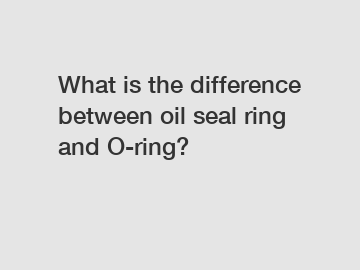What is the difference between oil seal ring and O-ring?
What is the Difference between Oil Seal Ring and O-Ring?
Oil seal rings and O-rings are commonly used in various industries to prevent leakage and contamination of fluids or gases. While they serve a similar purpose, there are some key differences between these two types of seals. In this article, we will explore the distinctions between oil seal rings and O-rings, and how each one is used in different applications.
1. Oil Seal Rings: Providing Effective Sealing in Rotary Applications.

Oil seal rings, also known as rotary shaft seals or lip seals, are specifically designed for rotary applications where a rotating shaft is passing through a housing or bore. These seals are mainly used to retain lubricants and prevent the ingress of contaminants, such as dirt, dust, or liquids, into the machinery.
H2: Structure and Function of Oil Seal Rings.
Oil seal rings typically consist of an outer metal case, an elastomeric sealing lip, a spring, and sometimes a garter spring. The metal case provides structural support and protects the elastomeric sealing lip from external damage. The sealing lip, usually made of rubber or elastomer, is in direct contact with the rotating shaft and creates a barrier to prevent fluid or gas leakage. The spring ensures the optimal contact and pressure between the sealing lip and the shaft, maintaining an effective seal.
H2: Applications of Oil Seal Rings.
Oil seal rings are commonly used in automotive applications, such as engines, transmissions, and wheel hubs, where they ensure that lubricants do not leak out while preventing the entry of contaminants. They are also used in industrial machinery, agricultural equipment, and marine applications, providing protection against oil leaks and maintaining the efficiency and longevity of the equipment.
2. O-Rings: Providing Reliable Sealing in Static and Dynamic Applications.
O-rings, also known as mechanical gaskets or packing rings, are widely used in both static and dynamic applications. Unlike oil seal rings, O-rings are not limited to rotary shafts but are suitable for sealing other types of connections, including pipes, tubes, and cylinders.
H2: Structure and Function of O-Rings.
O-rings are simple and versatile seals that consist of a circular cross-section made of elastomeric material. The round shape of the O-ring allows it to be compressed between two mating surfaces, creating a tight seal. When the O-ring is squeezed, it deforms and fills in any irregularities or gaps between the surfaces to prevent leakage.
H2: Applications of O-Rings.
O-rings find applications across various industries, including hydraulic systems, pneumatic systems, plumbing, and automotive. They are used in static applications, such as pipe connections, valve seals, and flange gaskets, as well as dynamic applications, such as piston seals and hydraulic cylinder seals. O-rings are known for their durability, reliability, and cost-effectiveness.
In conclusion, while both oil seal rings and O-rings serve the purpose of sealing and preventing leakage, they are designed for different applications and have distinct structures. Oil seal rings are used in rotary applications, specifically for sealing rotating shafts, while O-rings have a wider range of applications in both static and dynamic connections. Understanding the differences between these seals is essential for selecting the most suitable option for specific industrial or mechanical requirements.
If you have any further questions or need assistance in choosing the right seal for your application, please do not hesitate to contact us.
Are you interested in learning more about rubber gasket square, colored rubber rings, low price nbr r37 cloth rubber oil seal? Contact us today to secure an expert consultation!


